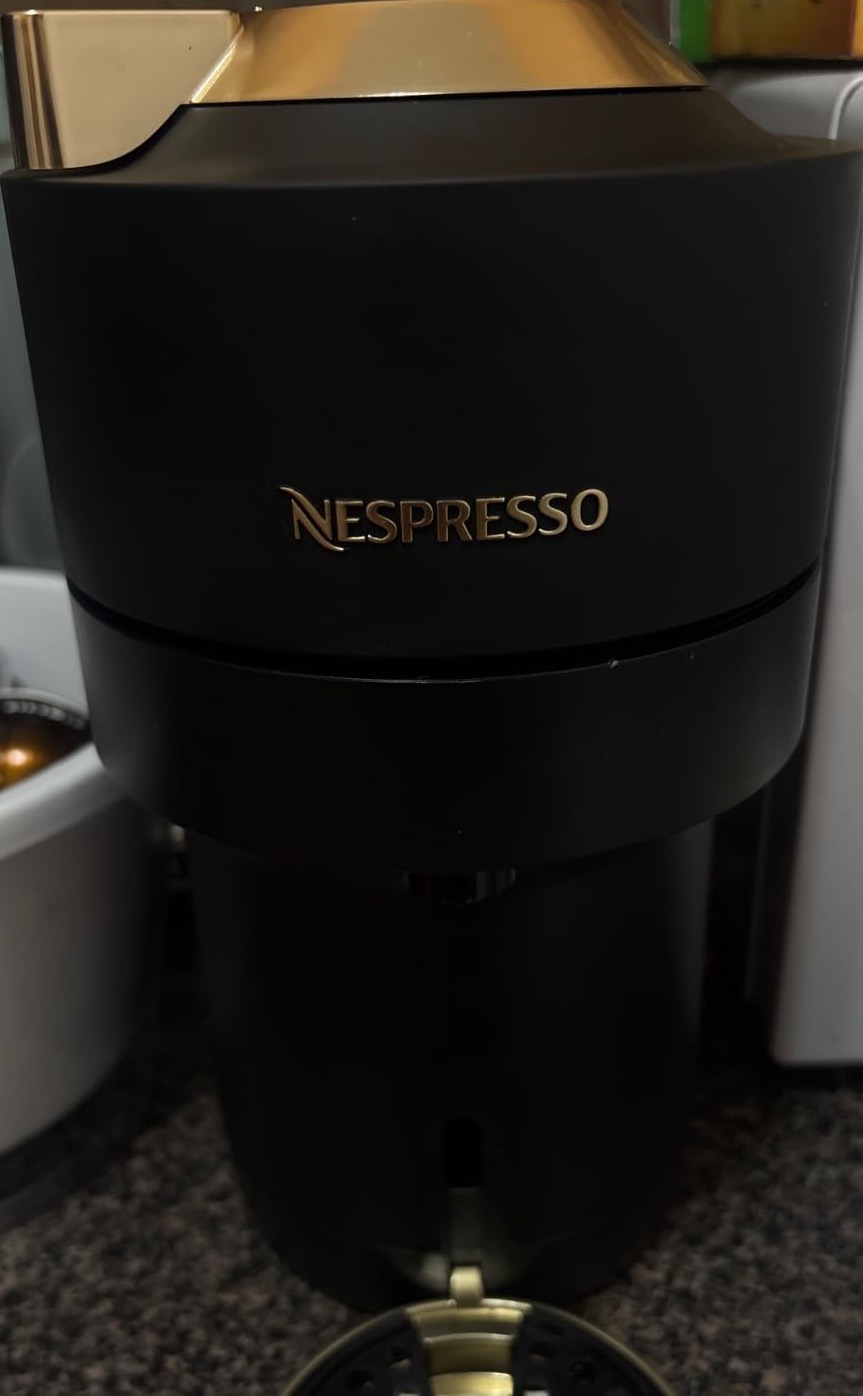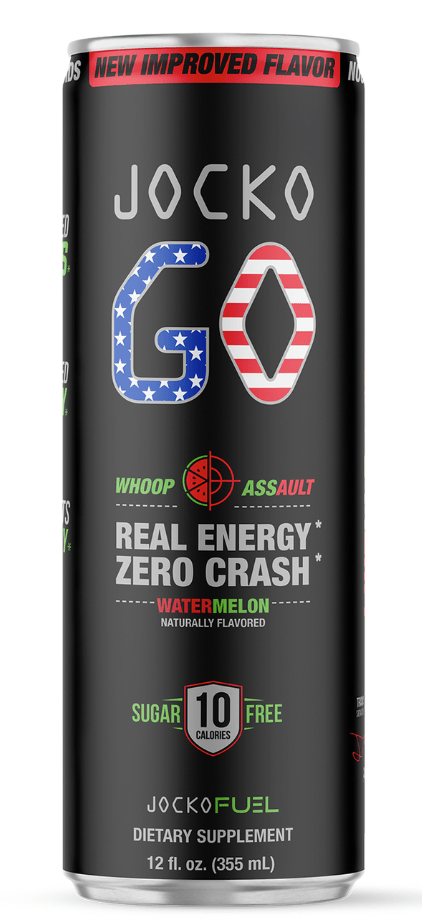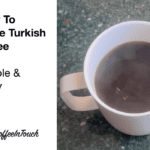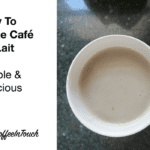matt
Best Aeropress Recipe
The perfect cup of joe can transform your morning, fuel your day, and even become a cherished ritual. With various brewing methods available, the AeroPress stands out for its portability, versatility, and ability to produce an exceptional cup of coffee. If you’re searching for the “best AeroPress recipe,” you’re likely driven to make your coffee experience as delightful as possible. This article will guide you through what you need to know to find your perfect brew.
The Variables that Matter
When brewing with an AeroPress, several variables can significantly impact your coffee’s flavor, aroma, and mouthfeel. These include:
- Grind Size: Affects the extraction rate and, consequently, the taste.
- Water Temperature: Determines how efficiently the flavors are extracted from the coffee grounds.
- Coffee-to-Water Ratio: Influences the strength of your brew.
- Steeping Time: Longer steep times can produce a more robust flavor but may also introduce bitterness.
Fantastic AeroPress Recipe: The Flavorful Fusion
Ingredients:
- Freshly ground coffee (medium-fine grind): 18 grams
- Hot water at 92°C (198°F): 250 ml
- A paper filter for the AeroPress
Equipment Needed:
- AeroPress Coffee Maker
- Electric Kettle
- Burr Coffee Grinder
- Measuring Scale (.001g accuracy is important)
- Timer
Instructions:
- Prep the AeroPress: Place a paper filter in the AeroPress cap and rinse it with hot water to remove any paper taste. Attach the cap to the AeroPress and set it on your mug or coffee server.
- Weigh and Grind: Measure 18 grams of your favorite coffee beans and grind them to a medium-fine consistency.
- Heat the Water: Bring your water to 92°C (198°F). If you don’t have a temperature-specific kettle, bring the water to a boil and let it sit for about 30 seconds to reach the desired temperature.
- Add Coffee: Place your AeroPress on the measuring scale and tare it. Add freshly ground coffee to the AeroPress chamber.
- First Pour: Start your timer and pour 100 ml of hot water into the AeroPress. Make sure all the coffee grounds are saturated. Let it bloom for 30 seconds.
- Stir and Steep: After the 30-second bloom, give the coffee a gentle stir.
- Second Pour: Add 150 ml of hot water to the AeroPress.
- Seal and Steep: Insert the plunger into the AeroPress to create a vacuum seal. This prevents the coffee from dripping through. Allow the coffee to steep for an additional 1 minute.
- Press: After the steeping time is up, press down on the AeroPress plunger with steady pressure. The press should take about 30 seconds.
- Serve and Enjoy: Your coffee is now ready! Please give it a quick stir and enjoy your delicious, smooth, and aromatic AeroPress coffee.
Optional:
- For an extra kick, add a tiny pinch of salt or a dash of cinnamon to the coffee grounds before brewing.
Why This Recipe Works:
- The two-stage pouring process allows the coffee to bloom, releasing carbon dioxide and aiding in even extraction.
- The medium-fine grind and 92°C (198°F) water are optimized for a balanced extraction, resulting in a rich and smooth cup.
- The vacuum seal helps maintain the brewing temperature and prevents dripping, ensuring that your coffee extracts evenly.
Enjoy your Awesome AeroPress coffee! Feel free to adjust the variables to suit your taste preferences better.
The Aeropress Original Coffee Press is a versatile and innovative coffee brewing device that promises to revolutionize your coffee experience. This product is designed to extract the best flavors from your coffee beans, consistently delivering a smooth, rich, and grit-free brew.
- Versatile Brewing: Combines the principles of French press, pour-over, and espresso brewing methods.
- Superior Extraction: Uses agitation, pressure, and micro-filtration to produce a smooth, rich, and grit-free coffee.
- Durable Material: Made from a shatterproof material that can withstand daily use.
- Easy to Clean: Designed for quick and easy cleaning after each use.
- Lightweight Design: Ideal for coffee lovers on the go.
- Highly Rated: Has an impressive rating of 4.7 out of 5 stars based on 19,702 reviews.
What is an AeroPress?
Before diving into recipes, it’s essential to understand what an AeroPress is. A portable coffee maker brews coffee by pressing hot water through a paper filter and ground coffee. Designed for ease of use, the AeroPress has become a favorite among novices and coffee connoisseurs.
Wrapping Up Aeropress Coffee
The AeroPress coffee maker has gained a loyal following among coffee aficionados and casual drinkers alike and for good reasons. One of the key features that sets AeroPress apart is its immersion-style brewing method. In this process, medium-fine ground coffee is fully immersed in hot water, allowing for a robust and even extraction of flavors. This is a departure from methods like drip coffee making, where water passes through the coffee grounds rather quickly, sometimes resulting in uneven extraction.
The AeroPress also boasts a shorter brew time compared to other methods. While you might think a quick brew could compromise flavor, it’s quite the opposite. The shorter brewing time helps reduce bitterness and acidity, two elements that can mar the taste of your coffee. This unique advantage of AeroPress is that it allows for a rich, full-bodied cup of coffee without the harshness often associated with more extended brewing methods.
What truly elevates the AeroPress experience is using a micro-filter and a plunger to create pressure during the brewing process. This pressure catalyzes extracting a broader spectrum of flavors and aromas from the coffee grounds. The micro-filter ensures the final brew is smooth and grit-free, capturing even the finest coffee particles. As a result, you’re left with a cup of coffee that’s not just rich and flavorful but also remarkably clean.
Despite the complexity behind the scenes, using an AeroPress is remarkably straightforward. It essentially boils down to three main steps: measuring the coffee and water, stirring the mixture, and pressing the plunger. This simplicity makes it accessible for coffee lovers who may not have barista-level skills but still crave a high-quality cup of coffee at home or on the go.
In summary, the AeroPress offers a unique combination of immersion-style brewing, quick extraction time, and pressure-induced flavor extraction; all wrapped up in an easy-to-use package. Whether you’re an experienced coffee connoisseur or a beginner, AeroPress provides an uncomplicated route to a cup of coffee that is both complex in flavor and smooth in texture.
Why the Nespresso Vertuo Pop+ Deluxe Is the Best Espresso Machine Under $200
I’ve tested a lot of espresso machines over the years — everything from $70 budget models to $700 semi-automatic setups — and honestly, most machines under $200 just don’t deliver. Weak espresso, inconsistent shots, annoying maintenance… it’s a mess.
But the Nespresso Vertuo Pop+ Deluxe by Breville?
This one surprised me. In fact, it’s the first machine under $200 that I actually kept on my kitchen counter because I use it every single day.
If you want fast, legit espresso without spending big money or learning barista skills, this is hands-down the best option in the price range. Here’s why.
1. The Espresso and Crema Are Shockingly Good
I expected “okay” espresso.
What I got was real crema, rich flavor, and the closest thing to a coffee shop shot you’ll get from a machine this cheap.
Vertuo pods spin at high speeds, and that extraction creates a thick, velvety crema you cannot get from Keurig-style machines. Even compared to manual budget machines, the flavor is stronger and more consistent.
I’ve had tons of machines that made “espresso,” but this one actually tastes like it.
2. One Button. No Mess. No Thinking.
The reason I use this every day?
It’s stupidly easy.
-
Pop in a pod.
-
Press the button.
-
That’s it.
It auto-detects the pod size, sets the brew strength, and even has a quick 3-tap cleaning mode. I don’t have to grind beans, tamp, purge, or clean portafilters. I just get great espresso in 30 seconds.
This one-button simplicity is the #1 reason I prefer it over budget manual espresso machines.
3. It Makes Coffeehouse Drinks Without Coffeehouse Effort
If you get the bundle with the milk frother, you basically unlock lattes, cappuccinos, macchiatos, and iced drinks with zero skill.
I’ve made drinks at home that I used to buy at Starbucks — and the difference in cost adds up fast.
This machine honestly makes:
-
better iced lattes
-
stronger flavored drinks
-
better crema
-
more consistent espresso
…than any $200 machine has any right to.
4. It’s Compact and Looks Great in Any Kitchen
One of my biggest complaints with espresso machines is that they eat up counter space.
The Vertuo Pop+ is tiny.
It fits under cabinets, doesn’t hog counter space, and the Matte Black Gold version looks high-end without costing high-end money.
It’s basically “Breville style on a budget.”
5. It’s Fast, Reliable, and Foolproof
I’ve used mine every day for months, and it hasn’t glitched once.
-
No leaks
-
No pressure issues
-
No temperature drama
-
No weird maintenance
It’s just reliable. Press the button → get great espresso. Every time.
Under $200, this kind of consistency is rare.
6. The Pod Variety Is Actually Fun
I didn’t expect to enjoy trying different pods, but the Vertuo line is massive:
-
strong espressos
-
flavored coffees
-
seasonal blends
-
iced pods
-
lungo options
I’ve found a few favorites that I buy in bulk now, and it keeps the daily routine interesting without effort.
7. The Price-to-Performance Ratio Is Unbeatable
This is the part that seals the deal for me:
👉 It performs like a mid-range espresso machine but costs under $200.
Even better, it regularly goes on sale for $129–$159, and the frother bundle adds even more value.
For someone who wants:
-
better-than-Keurig coffee
-
real espresso
-
low effort
-
compact size
-
café-style drinks
…this machine hits all the boxes without going anywhere near the $500+ bracket.
Things to Know (Honest Downsides)
No machine is perfect, so here’s the quick, real version:
-
It’s a little noisy when spinning pods
-
The coffee is hot, but not too hot
-
The frother quality is hit-or-miss for some people
-
Tall iced coffee cups don’t fit unless you remove the tray
-
Pods cost more than standard ground coffee
Electric Moka Pot & If It’s Right For You
Hey there, coffee enthusiasts! Let’s take a journey back in time to the origins of a classic coffee maker – the Moka Pot. You see, the Moka Pot has a rich history that dates back to the early 1930s in Italy, where it was invented by Alfonso Bialetti. Picture this innovative Italian engineer, inspired by the traditional brewing methods used in small cafes, setting out to create a coffee maker that could deliver that authentic Italian coffee experience right at home.
And boy, did he succeed! The Moka Pot quickly became an iconic symbol of Italian coffee culture, adorning kitchen counters all over Italy and beyond.
Now, let me introduce you to the modern marvel – the Electric Moka Pot! This bad boy takes the classic stovetop Moka Pot to a whole new level. No more fumbling around with flames and temperature control. The Electric Moka Pot brings convenience and ease to your coffee ritual with the simple push of a button!
 Electric Moka Pot
Electric Moka Pot
Imagine waking up to the aroma of freshly brewed coffee, thanks to this electric wonder. No more waiting around for your morning pick-me-up; the Electric Moka Pot gets the job done swiftly, giving you that perfect cuppa in no time.
But don’t you worry, it doesn’t compromise on the flavor. Oh no! The Electric Moka Pot preserves that authentic Italian coffee taste we all know and love. It still works its magic, extracting those bold and robust flavors that make you feel like you’re sitting in a charming cafe in Rome.
And let’s not forget about its sleek and modern design. This beauty not only brews like a pro but also adds a touch of style to your kitchen setup. It’s a real eye-catcher and sure to spark conversations with your coffee-loving friends.
So there you have it, a little trip down memory lane to the origins of the Moka Pot, and a warm introduction to its electric cousin. The Electric Moka Pot is your ticket to brewing coffee magic, blending tradition with modern convenience.
Get ready to embrace that Italian coffee experience right in the comfort of your own home. The Electric Moka Pot is waiting for you to take it for a spin, so go ahead and make every coffee moment a special one! Cheers to great coffee and the joys it brings!
Electric Moka Pot vs Stovetop Moka Pot
Comparing the classic stovetop Moka Pot with its modern cousin – the Electric Moka Pot.
Stovetop Moka Pots are the darlings of coffee purveyors worldwide. Found in traditional Italian cafes, they brew coffee with the power of steam, creating an authentic and delicious flavor profile. Just a pot, some heat, and your favorite coffee beans, and voilà – you’ve got a great-tasting coffee!
On the other hand, we have Electric Moka Pots, perfect for those who prefer convenience in the kitchen. With electrical power, you simply fill the boiling chamber with water, press a button, and bam! A delicious cup of coffee is on its way.
So which one’s better, you ask? It really depends on your lifestyle and preferences. Stovetop Moka Pots give you more control over the brewing process, allowing you to fine-tune the temperature for specific flavor profiles. On the flip side, Electric Moka Pots are great for folks without regular stove access, like dorm rooms, hotels, or workplaces. They sacrifice some control for ultimate convenience.
Can I Control The Brewing Process as Well?
Yes and no, the stove top version has better control over the heat settings because you have a flame that you can see underneath. If that isn’t important to you, it might not matter.
Does the Electric Moka Pot Maintain the Authentic Italian Coffee Experience?
While the finer controls of the coffee is different, you can still absolutely get a fantastic, authentic Italian coffee experience out of the electric moka pot.
Is the Electric Moka Pot as Durable?
In theory, yes. It depends on the quality of the moka pot you decide to get. But since the heating element is built within the moka pot, there isn’t much you can do if it were to break.
Another option that might work better is the induction friendly moka pots since they are heated externally and there are no mechanical pieces to break down the road. We recommend taking a look at the Bialetti Moka Pot Induction version. This is the original company that was started way back when, and their moka pots are synonymous with coffee in Italy. Personally, I would go this route over an electric version because this will last forever. I also like have the induction cook top in general because it’s a couple of spare burners that I can travel with so the money is better spent in my opinion.
Best Coffee For a Moka Pot
We have a piece on the best coffee for a moka pot here but if you want to make a long story short, we’ve been liking the San Francisco Bay whole bean French Roast / Dark Roast lately.
Moka Pot Grind Size
When it comes to brewing with a Moka Pot, you want coffee that boasts bold flavors and a smooth finish. Here are some key characteristics to look for in the best coffee beans for your Moka Pot:
- Medium to Dark Roast: Opt for beans with a medium to dark roast, as they bring out rich and intense flavors that stand up well to the Moka Pot brewing process.
- Single-Origin Arabica Beans: Look for single-origin Arabica beans, known for their complex flavors and balanced acidity, creating a more nuanced and delightful cup of coffee.
- Freshly Roasted: Always aim for freshly roasted coffee beans. The Moka Pot brings out the best in freshly roasted beans, offering a more vibrant and aromatic experience.
- Fine to Medium Grind: Grind your coffee to a fine to medium consistency. This allows for optimal extraction and a robust cup of coffee without over-extraction or bitterness.
- Flavor Notes: Seek out beans with flavor notes that complement your taste preferences. Whether it’s chocolatey, nutty, fruity, or spicy, finding the right flavor profile will enhance your coffee enjoyment.
How To Make Decaf Iced Coffee
Decaf iced coffee is perfect for those who want to enjoy a cool, flavorful coffee drink without the jolt of caffeine. Whether you’re looking for a quick fix or a smoother, long-steeped brew, this guide covers two easy methods to make your own refreshing decaf iced coffee at home.
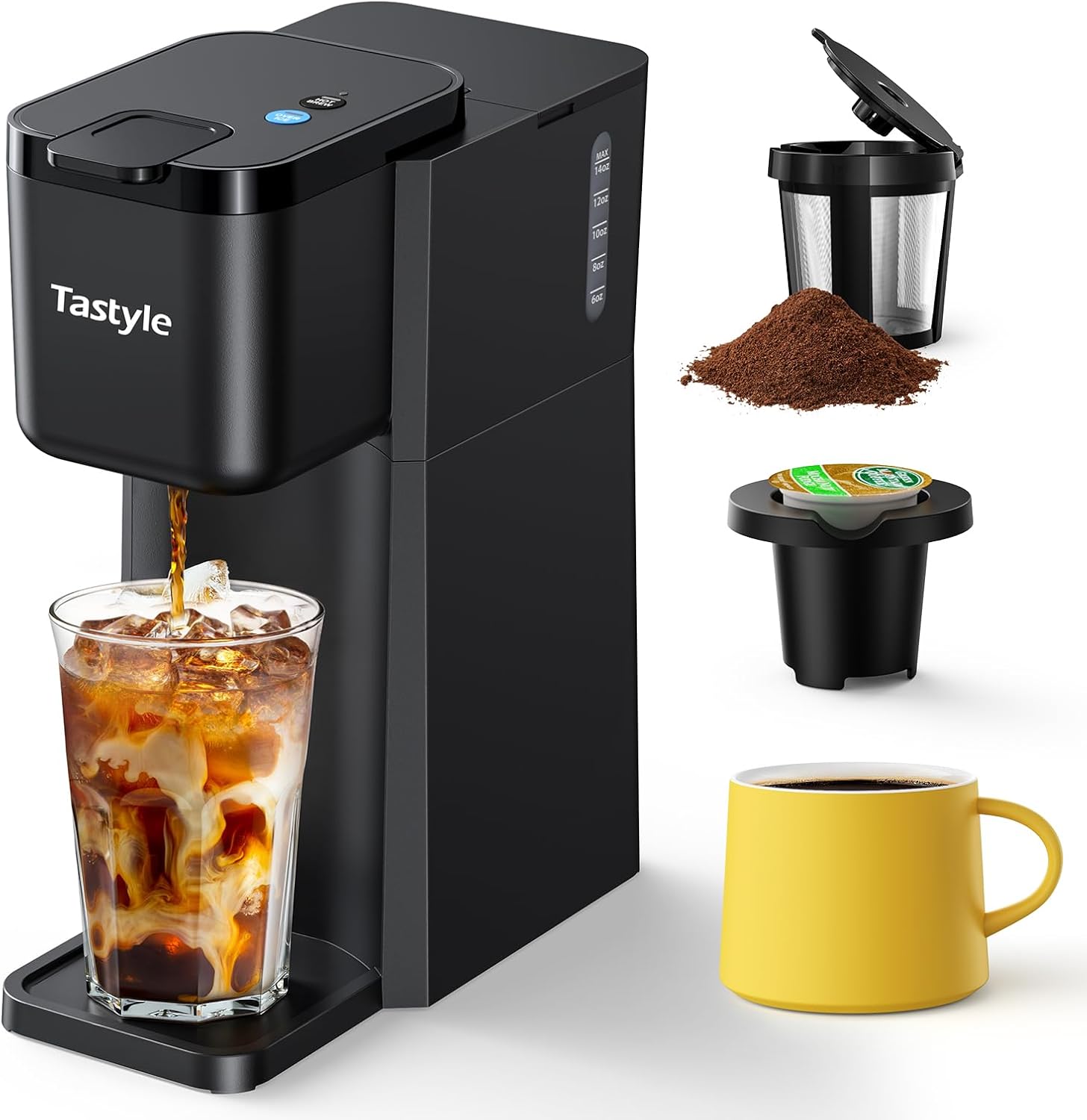
Click for favorite iced coffee maker
Decaf iced coffee offers all the rich flavors of regular iced coffee without the caffeine buzz. It’s a great choice for warm days or an afternoon pick-me-up when you want to avoid overstimulation. The best part? You can make it in your kitchen with minimal effort and ingredients.
Method 1: Instant Decaf Iced Coffee
When you’re short on time but still crave that iced coffee, the instant method is your go-to. It’s fast, simple, and satisfying.
Ingredients:
- 2 teaspoons of decaffeinated instant coffee granules
- 1 teaspoon of warm water
- 2 teaspoons of sugar or your favorite sweetener
- ½ cup of cold water
- 1 teaspoon of vanilla extract (optional)
- ½ cup of milk
- Ice cubes
Instructions:
- Dissolve the Coffee: Add the instant decaf coffee granules to a glass with warm water and stir until dissolved.
- Mix It Up: Pour in the sugar (or sweetener), cold water, and vanilla extract if you’re feeling fancy. Stir well.
- Serve It Cold: Fill a tall glass with ice and pour over the ice.
- Add the Creaminess: Top it with milk or a milk alternative, stir gently, and savor your instant decaf iced coffee.
Method 2: Decaf Cold Brew Iced Coffee
If you have a little more time on your hands, cold brew is the way to go. It’s smooth, less acidic, and perfect for sipping.
Ingredients:
- 1 cup of coarsely ground decaf coffee
- 4 cups of filtered water
- Milk or milk alternative (to taste)
- Sweetener (optional)
- Ice cubes
Instructions:
- Combine Coffee and Water: Place the coarsely ground decaf coffee in a large jar or pitcher. Pour the filtered water over it and stir until all the grounds are wet.
- Steep and Wait: Cover the jar and let it sit at room temperature for 14-24 hours. A longer steeping time means a stronger flavor.
- Strain It Out: Once it’s ready, strain through a fine-mesh sieve or use a coffee filter to remove the grounds.
- Serve It Up: Fill a glass with ice, pour in the cold brew and dilute it with water or milk to your liking. Sweeten it up if you prefer, and enjoy!
Stone Street Cold Brew Decaf Coffee Beans
Tips for Customizing Your Decaf Iced Coffee
One of the best things about making iced coffee at home is how you can tweak it to suit your taste. Here are some ideas:
Flavoring Options:
- Add flavored syrups like vanilla, caramel, or chocolate for a sweet twist.
- Top your drink with whipped cream and a little sprinkle of cinnamon for an indulgent treat.
- Want something unique? Mash up some berries or add a splash of lemonade for a fruity spin.
- Fresh mint leaves can give your drink a refreshing, herbal note.
Milk Alternatives:
- Almond milk, oat milk, or coconut milk if you’re dairy-free.
- For a richer experience, use condensed milk or full-fat coconut milk.
Sweeteners:
- Sweeten with classic sugar, honey, maple syrup, or flavored syrups.
- If you’re using sugar, dissolve it in warm coffee before cooling to make sure it blends in smoothly.
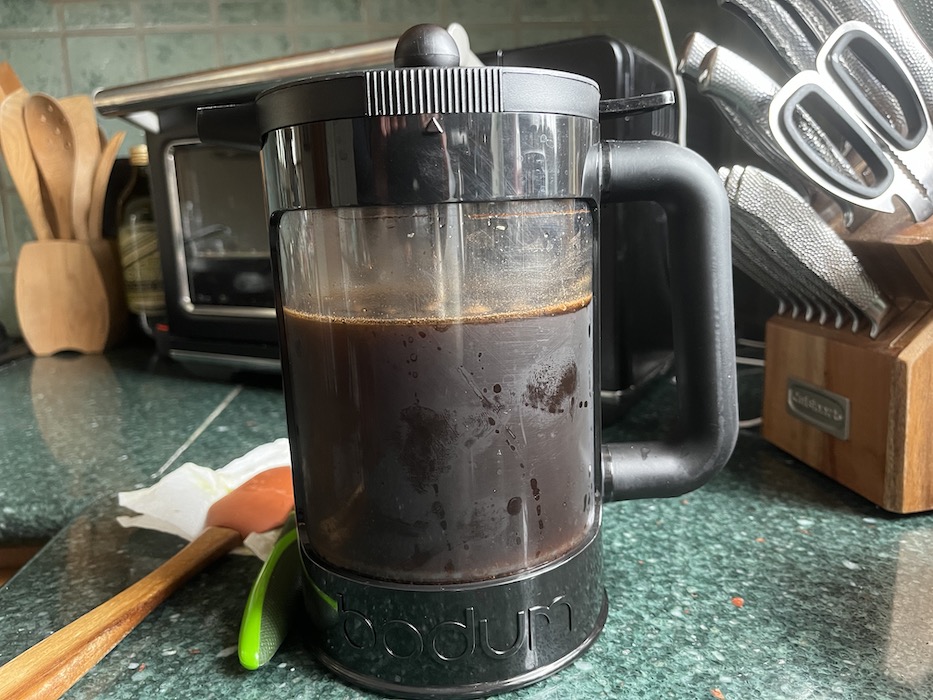
Click for ice coffee steeper
Choosing the Best Decaf Coffee
The flavor of your decaf iced coffee largely depends on the quality of the coffee you choose. Here are a few factors to consider:
- Roast Level: Light roasts are often more floral and bright, while medium and dark roasts bring out deeper, richer flavors.
- Decaffeination Method: The Swiss Water Process is a popular choice for those who want a chemical-free decaf.
- Recommended Brands: For top-notch flavor, try Peet’s Decaf Big Bang Cold Brew or Stumptown Coffee Roasters Trapper Creek Decaf Blend.
Conclusion
Making decaf iced coffee at home is simple and customizable, letting you tailor your drink exactly to your liking. Experiment with different methods, flavors, and ingredients until you find your perfect blend. So go ahead, whip up a glass, sit back, and enjoy a refreshing caffeine-free treat!
Jocko Go Energy Drink Rundown
The Jocko Go energy drink is part of the Jocko Fuel line of products, and it prides itself in using top-shelf ingredients. It has naturally sourced caffeine (95mg), typical in a cup of coffee. They use the best ingredients to give customers clean, sugar-free energy and focus to your day.
This blog post dives deep into what makes Jocko GO stand out in the crowded energy drink market, and we review the drinks too!
What’s In Jocko Go Energy Drink?
It prides itself on using monk fruit for sweetness, with zero crash, and a ton of vitamins and minerals. It is Keto friendly with amino acids, nootropics, and naturally sourced caffeine.
Best Jocko Go Flavor: Whoop Assault
Cracking the Jocko Go Whoop Assault, the taste of watermelon immediately hits and reminds me of something… It took a minute, but if you’ve ever had the watermelon Hubba Bubba Bubble Tape it’s kind of similar to that, only this is drinkable and not filled with undesirable ingredients. It’s by far my favorite flavor.
Whoop Assault also tastes similar to the watermelon drink that Trader Joe’s has during the summer months however this is sweetened moderately with monk fruit extract. It gives the drink a stronger taste, so it kinda kicks you in the face a bit and is enjoyable and refreshing without the guilt of drinking something with a bunch of barely understandable ingredients.
Jocko Go Review
Jocko GO’s diverse flavor lineup is a standout feature, catering to a wide range of palates. The collection includes Mango Passionfruit, Blue Raspberry, Pink Lemonade, Sour Apple, Tropic Thunder, Savage, Watermelon Assault, and Mango Mayhem, offering a spectrum of tastes from tropical to tangy. While flavor perceptions are totally subjective, the drinks are, in my opinion, excellent. The carbonation adds a refreshing touch, though the monk fruit aftertaste is noticeable to some.
 See All Jocko Go Flavors
See All Jocko Go Flavors
Jocko Go Flavor Table
| Jocko Go Flavors | Short Summary | Unique Ingredients | Price |
|---|---|---|---|
| Pink Mist | Refreshing, tangy with a hint of raspberry. Mixed reviews on Amazon. | Vitamin C, L-theanine, L-tyrosine | $35.99 |
| Tropic Thunder | Blend of pineapple, mango, coconut. Praised for being refreshing and keto-friendly. | B vitamins, antioxidants | $35.99 |
| Whoop Assault | Juicy and sweet, tastes like fresh watermelon. Reviews are mixed. | L-theanine, L-tyrosine | $35.99 |
| Mango Mayhem | Smooth and creamy blend of mango and vanilla. Reviews vary on Amazon. | Green tea extract, ginger root extract | $35.99 |
| Afterburner Orange | Zesty, citrusy with a touch of ginger. Positive reviews for energy and focus. | Beta-alanine, citrulline malate | $35.99 |
| Sour Apple Sniper | Crisp and tart green apple flavor. Reviews on Amazon are mixed. | Taurine, acetyl-L-carnitine | $35.99 |
| 50 Tea/50 Lemonade | Classic blend of black tea and lemonade. Known as Arnold Palmer. Mixed reviews. | EGCG, quercetin | $35.99 |
| Dak Savage | Bold and spicy with black cherry and a hint of cayenne. Positive customer feedback. | Creatine monohydrate, beta-hydroxybutyrate | $35.99 |
| Citrus Psycho | Bright and fizzy, lemon-lime with a splash of grapefruit. Generally positive reviews. | Guarana extract, yerba mate extract | $35.99 |
Where to Buy Jocko Go?
Jocko GO energy drinks are available online and are supported by Amazon. You can also find them in selected stores. As they are produced by Jocko Fuel, a small business brand, purchasing these drinks also supports small enterprises.
Jocko Go Ingredients
Natural Ingredients
One of the standout features of Jocko GO is its commitment to natural ingredients. Unlike many energy drinks, Jocko GO doesn’t contain any artificial sweeteners or colors. Its key ingredients include 95 mg of caffeine, monk fruit as a natural sweetener, and essential electrolytes.
Cognitive and Physical Boost
Jocko GO isn’t just about physical energy; it’s designed to boost your mind as well. It promises cognitive and physical uplifts without the dreaded crash commonly experienced with other brands. This dual-action makes it a preferred choice for those who need both mental clarity and physical stamina.
Zero Sugar & Keto-Friendly
Health-conscious consumers will be glad to know that all Jocko GO drinks are sugar-free and keto-friendly, making them a perfect companion for a low-carb diet.
Vitamin B6
This essential vitamin is crucial for synthesizing neurotransmitters, which are key players in mood stabilization, hunger regulation, and sleep patterns. It also aids the formation of red blood cells and in breaking down nutrients to generate energy.
Vitamin B12
This nutrient is vital for creating red blood cells, sustaining a healthy nervous system, and in the making of DNA. It’s also instrumental in transforming nutrients into fuel for the body.
Choline
This essential nutrient is significant for cognitive functions, memory retention, and neurotransmitter formation. It’s also pivotal for preserving cellular membrane health.
Magnesium
This mineral participates in numerous physiological activities, including the generation of energy, creation of proteins, and the functioning of muscles and nerves.
Sodium
This element is crucial for retaining the body’s fluid equilibrium and is involved in the management of blood pressure and blood volume.
Potassium
This mineral is key in controlling fluid balance, as well as in the operation of muscles and nerves. It’s also beneficial for sustaining healthy blood pressure ranges.
Acetyl L-Carnitine
Known for its potential in combating Alzheimer’s disease, this nutrient is utilized for augmenting cognitive abilities, memory functions, and for minimizing fatigue post-physical activity.
Alpha-GPC
Documented for its cognitive enhancements, such as bolstered memory, heightened focus, and clearer thinking. It’s thought to function by raising acetylcholine levels in the brain, a neurotransmitter involved in various brain activities like memory retention and attention span.
Theobromine
A natural compound in cacao plants, theobromine is a stimulant that affects the central nervous system, enhancing attentiveness and vigor. It also elevates cardiac rate and blood circulation, while mildly promoting fluid excretion. In moderate quantities, it can induce a state of happiness and boost mood.
L-Theanine
Found in tea leaves, especially green tea, this non-protein amino acid is celebrated for its tranquilizing and soothing effects. It elevates specific neurotransmitters in the brain like dopamine, GABA, and serotonin, which help in mood stabilization and stress alleviation. Alongside its calming attributes, L-Theanine also enhances mental sharpness and focus by increasing alpha brain wave levels, associating it with a relaxed yet alert mental state. This makes it a sought-after component in supplements designed for both relaxation and concentration.
Wrapping Up Jocko Go
I love Jocko Go, and I’ve enjoyed trying them all out to find the flavor that I like. It takes some experimentation, no doubt, but if you check the reviews on Amazon, it enjoys a favorable reception with a 4.3 out of 5 stars rating from over 8,092 global ratings. Not bad. Reviewers praise its clean ingredients, sustained energy boost without a crash, and health benefits. Criticisms mainly revolve around the monk fruit aftertaste, the quality of the can, and the watermelon flavor’s taste. But again, that’s subjective and you don’t know till you try it for yourself.
Does Coffee Ice Cream Have Caffeine?

Yes expect to find around 1 to 50 mg (milligrams) of caffeine in a single serving of coffee ice cream.
Some ice cream makers use coffee extracts, while others use actual coffee.
If the coffee extract is used, you may have a higher concentration of caffeine in your coffee ice cream. This is because coffee extracts have more caffeine than actual coffee.
How Much Caffeine Is In Popular Coffee Ice Creams?
| Coffee Ice-Cream Brand | Caffeine Count (per 60ml scoop) |
| Häagen-Dazs Coffee Ice Cream | 12.95 mg |
| Ben & Jerry’s Coffee Buzzbuzzbuzz | 17.75 mg |
| Breyer’s Coffee Ice Cream | 7.62 mg |
| Turkey Hill Colombian Coffee Ice Cream | 15.1 mg |
| Oatly Coffee Frozen Dessert | 20.4 mg |
This is not a lot of caffeine since a single cup of Grande Americano at Starbucks alone would have around 225 mg of caffeine.
Another way to compare the amount of caffeine inside coffee ice cream is against what the FDA (Food and Drug Administration) recommends.
The FDA recommends healthy adults avoid consuming more than 400mg of caffeine a day. Anything beyond that usually may come with side effects, such as headaches or dehydration.
If you are to eat a serving of coffee ice cream or two, you are not going to hit the caffeine limit. It will take a lot of coffee ice cream servings to reach the 400mg limit.
That means the amount of caffeine in coffee ice cream is very small. Feel free to eat and not worry too much!
We decided to look at several popular coffee ice-creams you may find on your shopping aisles and ran the numbers for you.
Häagen-Dazs Coffee Ice Cream
Who does not think of Häagen-Dazs first when it comes to ice cream? Their coffee ice cream is also one of their most popular options.
One good thing is that their coffee ice cream seems to have a very low caffeine count, with around 12.95mg per scoop. This should mean you can enjoy many before hitting the daily caffeine limit.
Ben & Jerry’s Coffee Buzzbuzzbuzz
Ben & Jerry’s may also be the most popular coffee ice cream. In their case, a single scoop of their Buzzbuzzbuzz Coffee Ice Cream would load you up with 17.75 mg of caffeine.
That’s slightly more than the rest but still well within the FDA’s recommendation of no more than 400 mg daily.
Breyer’s Coffee Ice Cream
Breyer’s coffee ice cream is also light on caffeine and is one of the more affordable options. A single scoop only comes with 7.62 mg of caffeine.
This is the least amount of caffeine you can have in a single scoop of coffee ice cream from this list, which means if you are really watching your caffeine count, get a tub of Breyers.
Turkey Hill Colombian Coffee Ice Cream
The Turkey Hill Colombian Coffee Ice Cream may use Colombian coffee. Still, it is cheaper than Ben and Jerry’s or Haägen-Dazs.
A single scoop will load you up with around 15 mg of caffeine. This is not too high compared to the other coffee ice cream on the list.
Oatly Coffee Frozen Dessert
If you plan to stay away from dairy, Oatly is a great alternative. In fact, Oatly’s coffee ice cream is dairy free too, which is why they call it a frozen dessert instead.
However, it does deliver a bit of a bang on the caffeine. A single scoop contains 20.4 mg of caffeine, the highest on the list.
Can You Enjoy Coffee Ice Cream Without Caffeine?
Suppose you plan to go completely caffeine free, yet you enjoy coffee. Is there a way to enjoy coffee ice cream without caffeine?
Generally, it is quite hard to get caffeine-free coffee ice cream. This is because the amount of caffeine in coffee is already quite small, which means not many people will demand a caffeine-free version of coffee ice cream.
This is unlike regular decaf coffee. There is a demand for decaf coffee since coffee drinks have more caffeine. This means those with caffeine sensitivity will feel the effects of the drug.
Making it yourself is probably your best bet to enjoy caffeine-free coffee ice cream. Making ice cream is not that difficult since there are ice cream machines.
Just make a shot or two of espresso with decaf coffee beans, and mix them with the other ingredients to make your coffee ice cream instead.
Nigel Ong Ph.D is a writer. He works closely with B2C and B2B brands to create content to build traffic, leads, and conversions for their website. His favorite coffee is the Long Black, piping hot, with no sugar.
Thank You For Subscribing
Thank you for subscribing to our monthly newsletter! You can expect us (info@coffeeintouch.com) to send you the coffee of the month, new equipment we’re playing around with, and other exciting things!
Please make sure to add us to your address book!
Talk soon…
Matt
How To Make Turkish Coffee
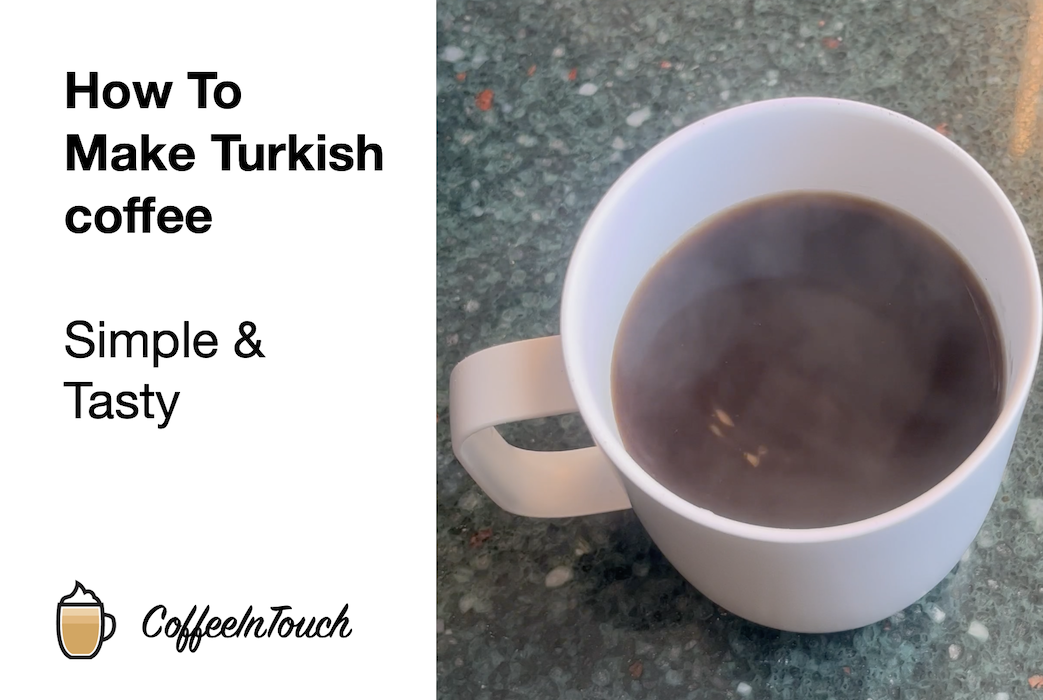
Turkish coffee is a traditional coffee that dates back to the 16th century where it quickly became a cultural staple to Turkish life. Turkish coffee is a delicious, special cup of coffee that will leave you wanting more and more!
In this article, I’ll go over the ingredients and gear you’ll need to make this coffee. I also made a video that lays out the process and a Pinterest pin just in case you’d like to pin it for later!
What Is Turkish Coffee?
Turkish coffee is traditionally coffee that has been brewed in a cezve, a small metal pot that is heated over a flame. Fine ground coffee is directly added to water, it’s boiled, then served unfiltered. Since the coffee grounds are fine, they tend to settle at the bottom of the cup, which makes Turkish coffee a special delight.
https://youtu.be/6urtLkqTmqM
What’s In Turkish Coffee?
Turkish coffee is made with:
- Finely ground medium roast coffee
- Sweetener (optional)
Regarding the coffee beans used, I like Peet’s Major Dickason’s for a lot of my coffee needs. But any freshly roasted beans work fine. I recommend going with a medium roast like Lifeboost, as we’re grinding the coffee to be pretty fine. A finely ground coffee gives it a lot of surface area and extraction (since we’re essentially cooking it twice) and a medium roast will help prevent bitterness.
 Regarding adding any sweetener, it is traditionally added in during the brewing process. Not afterwards. This makes for a much more uniform flavor, and keeps Turkish coffee feeling fresh!
Regarding adding any sweetener, it is traditionally added in during the brewing process. Not afterwards. This makes for a much more uniform flavor, and keeps Turkish coffee feeling fresh!
How To Make Turkish Coffee Without an Ibrik
Prep time: 12 Minutes
Turkish coffee is relatively easy to make. All you need is some fine ground coffee, a method of measuring and boiling water (we used a moka pot base), and a little patience!
Ingredients:
- 8-9 ounces water
- 2 teaspoons finely ground coffee
- 1/32 teaspoon of Sweet Leaf stevia
Instructions:
- Grind to a fine ground, 2 teaspoons of coffee
- Measure 8 ounces a filtered water
- Combine the coffee and the water in a small pot and place on a medium-low heat. Cover.
- After 4-5 minutes, remove from heat and remove any surface foam
- Add sugar or sweetener, if any
- Continue to heat and remove once it begins to boil
- Allow the coffee grounds to settle for a few minutes
- Pour and allow another minute for coffee to settle
- Enjoy!
Recommended Products
Conclusion
In conclusion, Turkish coffee is a traditional and beloved beverage that has been enjoyed for centuries throughout Turkey and the Middle East. It is a unique coffee preparation method that involves brewing finely ground coffee beans in a special pot called a cezve, with sugar and water. Turkish coffee is known for its strong flavor, thick consistency, and rich aroma.
Turkish coffee has not only been an important cultural tradition, but also plays a significant role in social gatherings and hospitality. It is often served with sweets, dates, or other snacks, and the preparation and serving of Turkish coffee is considered an art form in many communities.
Whether enjoyed for its taste, cultural significance, or social value, Turkish coffee remains a popular beverage around the world. Its unique preparation and rich history make it a fascinating topic for coffee lovers and cultural enthusiasts alike.
How To Make a Flat White
A flat white isn’t your every day, run of the mill cup of coffee. A flat white is a delicious, light, sweet experience to try if you haven’t. And an experience it is. Today, I’m going to show you how to make a flat white!
I’ll give you a run down of what the coffee is, what it tastes like, along with a few extra tidbits.
Ready to learn more about making this delicious beverage? Let’s go!
What Is a Flat White Coffee?
A flat white is essentially a cappuccino without the foam, and it became popular here in the United States after Starbucks introduced it to its menu. The flat white can be thought of as the happy medium between a stronger latte, but without as much foam as a cappuccino. When comparing a flat white vs latte, the flat white has less milk in the beverage overall since we’re not adding a foam milk layer on top. Therefore the drink is stronger than a latte. Regarding a flat white vs cappuccino, it is similar in that we’re not including a foam milk layer on top. A flat white is made with steamed or heated milk that’s been frothed.
Ingredients Needed
To make a flat white, you’ll need the following ingredients:
- espresso
- 2% milk
- optional: ice
You can use any milk you desire, 2% just happens to froth well and holds up a lot better than other options.
What Is an Iced Flat White?
An iced flat white is actually much easier to make! Just add ice to the espresso, and don’t bother steaming any milk. If you want to froth the milk a bit while its cold, you can add it on top.
Flat White Recipe:
Instructions:
- Prepare 2 oz of espresso in your preferred method. Either pull two shots of espresso, or use a moka pot.
- Warm 4oz of milk either in the microwave or in a small saucepan. Microwave for 30 seconds, or warm on the stove 4-5 minutes but do not allow it to boil. If you have an espresso machine, you can use the steamed milk function and skip the next step.
- Use a hand frother for avbout 20-30 seconds. Allow the bubbles to fade, and continue to froth another 20-30 seconds until the milk looks thicker. Pop any large bubbles, and remove any bubbles from the top layer of the milk.
- Pour the espresso into the mug.
- Add the milk at the center of the beverage. The last bit of milk should be super thick, so pour that into the center of the drink.
- Enjoy!
How To Make a Starbucks Flat White
The Starbucks iteration is simple, just double the milk to 8oz and it should come out a lot closer to what you get in the store.
How To Make Cafe Au Lait
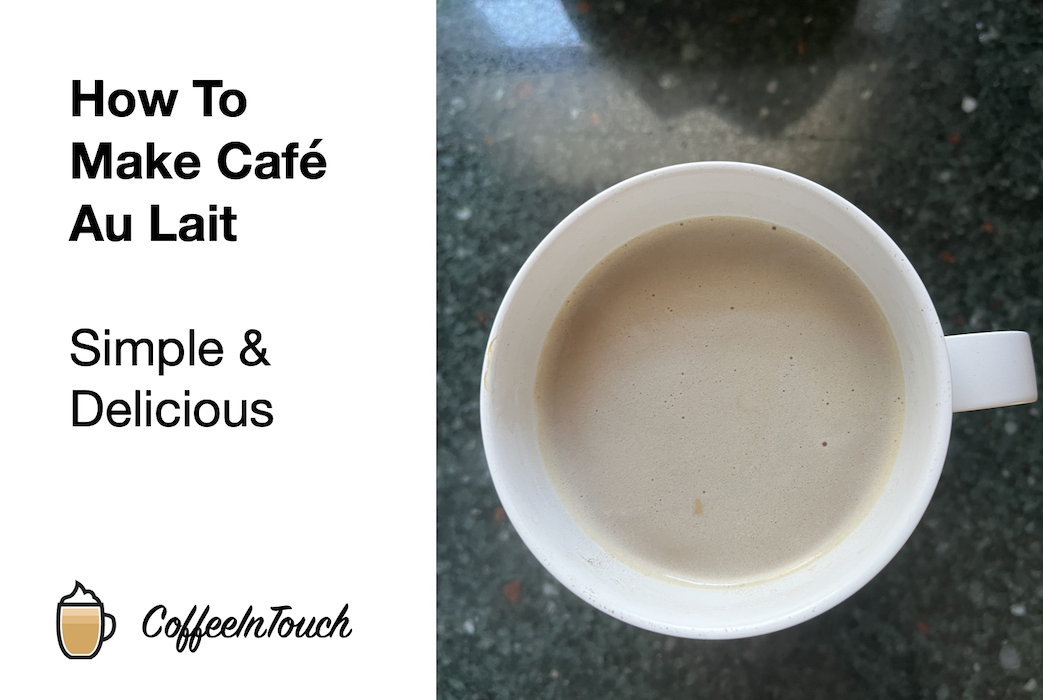
What Is Cafe Au Lait?
Café au lait is a popular coffee drink that originated in France and is made by combining brewed coffee with hot milk. The name “café au lait” literally means “coffee with milk” in French.
How To Make Cafe Au Lait?
Here is a simple recipe to make café au lait at home:
Ingredients:
- 1 cup of freshly brewed coffee
- 1 cup of whole milk
Instructions:
- Brew your coffee using your preferred brewing method. A French press or a drip coffee maker works well for making café au lait. In this case, I used my trusty moka pot.
- In a small saucepan, heat the milk over medium heat, stirring constantly to prevent scorching.
- Heat the milk until it is hot but not boiling and remove from heat.
- Pour equal parts of brewed coffee and hot milk into a mug.
- Stir the coffee and milk together until they are well combined.
- Enjoy your café au lait while it is still hot.
You can adjust the ratio of coffee to milk based on your personal preference, but a 1:1 ratio is traditional for café au lait. You can also add sugar or a sweetener of your choice if desired. Additionally, you can use a milk frother to create frothy milk, which will give your café au lait a creamier and richer texture.
Bonus Tip: I have a hand frother and gave my milk a quick whip before serving.
What Color Is Cafe Au Lait?
Café au lait is typically a light brown color, similar to the color of light cream or beige. The color can vary slightly depending on the type of coffee and milk used, as well as the ratio of coffee to milk. However, in general, café au lait has a light and creamy color that is characteristic of the combination of coffee and milk.
What Is The Difference Between Cafe Au Lait and Latte
Café au lait and latte are both coffee drinks that include steamed milk, but there are some key differences between the two:
- Origin: Café au lait originated in France and is traditionally made with brewed coffee and hot milk. Latte, on the other hand, originated in Italy and is made with espresso and steamed milk.
- Coffee-to-milk ratio: Café au lait typically has a 1:1 ratio of brewed coffee to hot milk, while a latte usually has a 1:3 or 1:4 ratio of espresso to steamed milk.
- Milk texture: The milk used in café au lait is typically heated to a lower temperature and has less foam than the milk used in a latte, resulting in a lighter and less creamy texture.
- Espresso vs. coffee: The biggest difference between café au lait and latte is the type of coffee used. Café au lait uses brewed coffee, while a latte uses espresso. Espresso is a concentrated coffee that is brewed under pressure, resulting in a stronger and more intense flavor than regular brewed coffee.
What Flavor Is Cafe Au Lait
Café au lait has a mild and smooth flavor that is a combination of the coffee and milk used in the drink. The coffee used in café au lait is typically a dark roast, which provides a bold and rich flavor, while the milk adds a creamy and slightly sweet taste to the drink. The combination of coffee and milk creates a balanced and comforting flavor profile that is often described as warm and comforting. The overall flavor of café au lait can vary depending on the type of coffee and milk used, as well as the ratio of coffee to milk, but it is generally a mild and pleasant coffee drink that is enjoyed by many.
